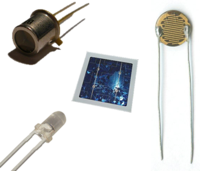
Photo from wikipedia
In this study, an external cavity-quantum cascade laser-based mid-infrared (IR) spectrometer was applied for in-line monitoring of proteins from preparative ion-exchange chromatography. The large optical path length of 25 μm… Click to show full abstract
In this study, an external cavity-quantum cascade laser-based mid-infrared (IR) spectrometer was applied for in-line monitoring of proteins from preparative ion-exchange chromatography. The large optical path length of 25 μm allowed for robust spectra acquisition in the broad tuning range between 1350 and 1750 cm–1, covering the most important spectral region for protein secondary structure determination. A significant challenge was caused by the overlapping mid-IR bands of proteins and changes in the background absorption of water due to the NaCl gradient. Implementation of advanced background compensation strategies resulted in high-quality protein spectra in three different model case studies. In Case I, a reference blank run was directly subtracted from a sample run with the same NaCl gradient. Case II and III included sample runs with different gradient profiles than the one from the reference run. Here, a novel compensation approach based on a reference spectra matrix was introduced, where the signal from the conductivity detector was employed for correlating suitable reference spectra for correction of the sample run spectra. With this method, a single blank run was sufficient to correct various gradient profiles. The obtained IR spectra of hemoglobin and β-lactoglobulin were compared to off-line reference measurements, showing excellent agreement for all case studies. Moreover, the concentration values obtained from the mid-IR spectrometer agreed well with conventional UV detectors and high-performance liquid chromatography off-line measurements. LC–QCL–IR coupling thus holds high potential for replacing laborious and time-consuming off-line methods for protein monitoring in complex downstream processes.
Journal Title: Analytical Chemistry
Year Published: 2022
Link to full text (if available)
Share on Social Media: Sign Up to like & get
recommendations!